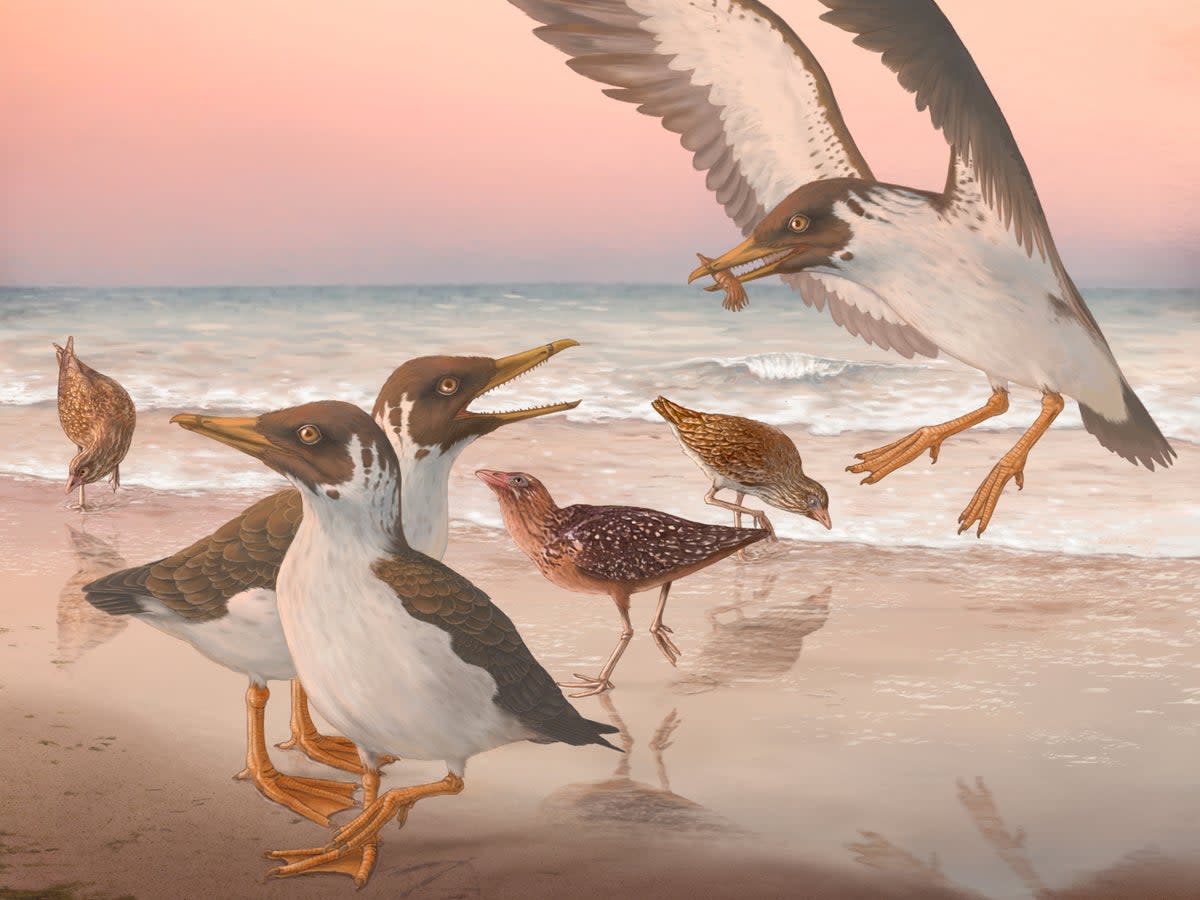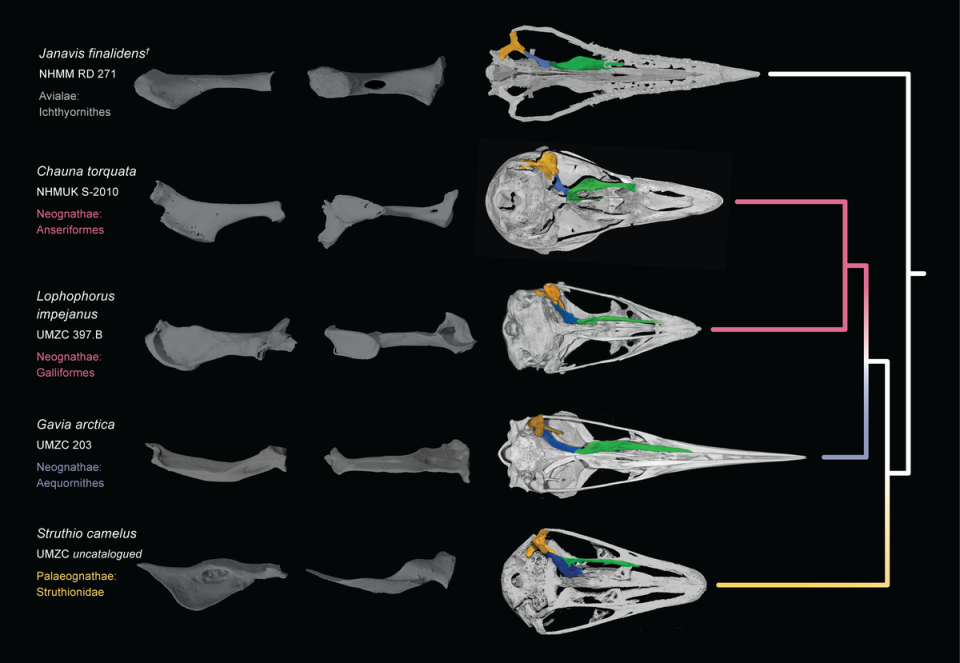Fossil ‘overturns more than a century of knowledge’ about evolution of birds

A re-analysis of a 66.7 million-year-old fossilised bird skeleton found on the Dutch-Belgian border in the 1990s has “upended” one of the core assumptions about the evolution of modern birds.
Until now it was thought that modern birds’ mobile, dextrous beaks – which they can move independently from their heads – evolved more recently, with birds such as ostriches and emus, who have fixed upper mandibles, emerging first.
However, a new study of the fossil reveals that mobile beaks had already evolved before the mass extinction event that wiped out dinosaurs.
It means that instead of bridging an evolutionary gap, birds such as ostriches and emus “evolved backwards” to attain a more simple beak design.
Today, around 99 per cent of all birds have mobile beaks.
Researchers from the University of Cambridge and the Natuurhistorisch Museum Maastrich used CT scanning techniques to identify bones from the roof of the mouth of a previously unknown species of a large fossilised ancient bird, which they named Janavis finalidens.
The team said it lived at the very end of the age of dinosaurs and was one of the last-toothed birds to ever live.
The arrangement of its palate bones shows that this “dino-bird” had a mobile beak, “almost indistinguishable from that of most modern birds”, they said.
The research team said their work “suggests that our understanding of how the modern bird skull came to be needs to be re-evaluated”.
Currently, each of the roughly 11,000 species of birds living on Earth today is classified into one of two overarching groups, based on the arrangement of their palate bones.
Ostriches, emus and their relatives are classified into the palaeognath, or “ancient jaw” group, meaning that, like humans, their palate bones are fused together into a solid mass.
All other groups of birds are classified into the neognath, or “modern jaw” group, meaning their palate bones are connected by a mobile joint.
Having a more agile beak is helpful for nest-building, grooming, food-gathering and defence.
But the emergence of a solid beak after the emergence of the more motile-hinged upper mandible, may require a significant rewrite of the history books.
The research team noted that the two beak classifications were originally made by Thomas Huxley, a British biologist who became known as “Darwin’s Bulldog” for his vociferous support of Charles Darwin’s theory of evolution.
In 1867, he divided all living birds into either the “ancient” or “modern” jaw categories. Huxley’s assumption was that the “ancient” jaw configuration was the original condition for modern birds, with the “modern” jaw arising later.
“This assumption has been taken as a given ever since,” said Dr Daniel Field from Cambridge’s Department of Earth Sciences, the paper’s senior author.
“The main reason this assumption has lasted is that we haven’t had any well-preserved fossil bird palates from the period when modern birds originated.”

The fossil, Janavis, was found in a limestone quarry near the Belgian-Dutch border in the 1990s and was first studied in 2002.
Since the fossil is encased in rock, scientists at the time could only base their descriptions on what they could see from the outside. They described the bits of bone sticking out from the rock as fragments of skull and shoulder bones and put the unremarkable-looking fossil back in storage.
But nearly 20 years later, the fossil was loaned to Dr Field’s group in Cambridge, and Dr Juan Benito, then a PhD student, started giving it another look.
“Since this fossil was first described, we’ve started using CT scanning on fossils, which enables us to see through the rock and view the entire fossil,” said Dr Benito, now a postdoctoral researcher at Cambridge, and the paper’s lead author.
“We had high hopes for this fossil – it was originally said to have skull material, which isn’t often preserved, but we couldn’t see anything that looked like it came from a skull in our CT scans, so we gave up and put the fossil aside.”
During the first Covid-19 lockdown, Dr Benito took the fossil out again. “The earlier descriptions of the fossil just didn’t make sense – there was a bone I was really puzzled by. I couldn’t see how what was first described as a shoulder bone could actually be a shoulder bone,” he said.
Dr Field said: “It was my first in-person interaction in months: Juan and I had a socially distanced outdoor meeting, and he passed the mystery fossil bone to me.
“I could see it wasn’t a shoulder bone, but there was something familiar about it.”
“Then we realised we’d seen a similar bone before, in a turkey skull,” said Dr Benito. “And because of the research we do at Cambridge, we happen to have things like turkey skulls in our lab, so we brought one out and the two bones were almost identical.”
They said that this realisation led the team to conclude that the unfused “modern” jaw condition, which turkeys share, evolved before the “ancient” jaw condition of ostriches and their relatives.
For an as-yet unknown reason, the fused palates of ostriches and kin must have evolved at some point after modern birds were already established.
“Evolution doesn’t happen in a straight line,” said Dr Field.
“This fossil shows that the mobile beak – a condition we had always thought post-dated the origin of modern birds, actually evolved before modern birds existed. We’ve been completely backwards in our assumptions of how the modern bird skull evolved for well over a century.”
The researchers say that while this discovery does not mean that the entire bird family tree needs to be redrawn, it does rewrite our understanding of a key evolutionary feature of modern birds.
The team said that the Janavis species did not survive the mass extinction event that marked the end of the Cretaceous period, and it went the same way as all the large dinosaurs and other toothed birds.
The species would have weighed around 1.5kg and was around the size of a modern vulture. A lack of food due to the collapse of food chains likely prevented the species’ survival, the team said.
The research is published in the journal Nature.

